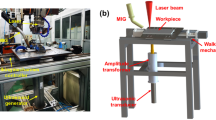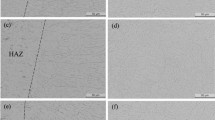Abstract
Ultrasonic-assisted laser-MIG hybrid welding (LMHW), the ultrasonic vibration applying respectively on the filler wire (LMHW-UF) and workpiece (LMHW-UW), was carried out on the 6 mm thick 6082-T6 aluminum alloy plates. The influences of the ultrasonic vibration modes on the weld formation, porosity defects, microstructure, microhardness, and tensile properties were investigated, and compared with those of the traditional laser-Mig hybrid-welded joints. The results indicated that the arc zone depths increased as the ultrasonic amplitudes increased, and which of the LMHW-UF and LMHW-UW joints were deeper than that of the LMHW joint. The porosity defect contents of the LMHW-UF and LMHW-UW weld seams were both smaller than that of the LMHW weld seams, especially of the LMHW-UF weld seams. The cellular dendrite size in the LMHW weld center was smaller than that in the LMHW-UF and LMHW-UW welds, and the parallel dendrite zone width of the LMHW weld was wider than that of the LMHW-UF and LMHW-UW welds, especially of the LMHW-UF weld. The lowest microhardness existed in the partially melted zone of the LMHW and LMHW-UW joints; however, the lowest microhardness existed in a certain distance from the fusion line of the LMHW-UF joints. The average tensile strengths of the LMHW, LMHW-UF, and LMHW-UW joints were 212.6 MPa, 237.5 MPa, and 228.2 MPa, the fractures occurred in the weld seam, near the fusion line and at the heat-affected zone, respectively. The LMHW and LMHW-UW joints both showed typical mixed ductile and brittle fracture feature, and the LMHW-UF joints showed representative ductile fracture feature.
Graphical Abstract








Similar content being viewed by others
Data availability
The data supporting the conclusions are included in the article.
References
Bunaziv I, Akselsen OM, Salminen A, Unt A (2016) Fiber laser-MIG hybrid welding of 5 mm 5083 aluminum alloy. J Mater Process Technol 233:107–114
Ning J, Na SJ, Wang CH, Zhang LJ (2021) A comparison of laser-metal inert gas hybrid welding and metal inert gas welding of high-nitrogen austenitic stainless steel. J Mater Res Technol 13:1841–1854
Ascari A, Foryunato A, Orazi L, Campana G (2012) The influence of process parameters on porosity formation in hybrid LASER-GMA welding of AA6082 aluminum alloy. Opt Laser Technol 44:1485–1490
Chen C, Zheng K, Zhang Y, Gao M (2021) Effect of kerf characteristics on microstructures and properties of laser cutting-welding of AA2219 aluminum alloy. J Mater Res Technol 15:4147–4160
Lamas J, Frostevarg J, Kaplan AFH (2015) Gap bridging for two modes of laser arc hybrid welding. J Mater Process Technol 224:73–79
Acherjee B (2018) Hybrid laser arc welding: State-of-art review. Opt Laser Technol 99:60–71
Nielsen SE (2018) High power laser hybrid welding - challenges and perspectives. Phys Procedia 78:24–34
Zhang C, Gao M, Wang D, Yin J, Zeng X (2017) Relationship between pool characteristic and weld porosity in laser arc hybrid welding of AA6082 aluminum alloy. J Mater Process Technol 240:217–222
Zhang C, Li G, Gao M, Yan J, Zeng XY (2013) Microstructure and process characterization of laser-cold metal transfer hybrid welding of AA6061 aluminum alloy. Int J Adv Manuf Technol 68:1253–1260
Zhang Y, Song X, Chang L, Wu S (2017) Fatigue lifetime of laser-MIG hybrid welded joint of 7075–T6 aluminum alloy by in-situ observation. Rare Metal Mat Eng 46:2411–2416
Han X, Yang Z, Ma Y, Shi C, Xin Z (2020) Porosity distribution and mechanical response of laser-MIG hybrid butt welded 6082–T6 aluminum alloy joint. Opt Laser Technol 132:106511
Alshaer AW, Li L, Mistry A (2014) The effects of short pulse surface cleaning on porosity formation and reduction in laser welding of aluminum alloy for automotive component manufacture. Opt Laser Technol 64:162–171
Leo P, Renna G, Casalino G, Olabi AG (2015) Effects of power distribution on the weld quality during hybrid laser welding of an Al-Mg alloy. Opt Laser Technol 73:118–126
Yin Y, Chen H, Yang X, He S (2019) Investigation of porosity in rotating laser-MIG hybrid welding A6N01 aluminum alloy. Int J Mod Phys B 33:1940029
Zhang C, Yu Y, Chen C, Zeng X, Gao M (2020) Suppressing porosity of a laser keyhole welded Al-6Mg alloy via beam oscillation. J Mater Process Technol 278:116382
Wang L, Liu Y, Yang C, Gao M (2021) Study of porosity suppression in oscillating laser-MIG hybrid welding of AA6082 aluminum alloy. J Mater Process Technol 292:117053
Hua C, Lu H, Yu C, Chen JM, Wei X, Xu JJ (2017) Reduction of ductility-dip cracking susceptibility by ultrasonic-assisted GTAW. J Mater Process Technol 239:240–250
Liu Z, Jin X, Li J, Hao Z, Zhang J (2022) Numerical simulation and experimental analysis on the deformation and residual stress in trailing ultrasonic vibration assisted laser welding. Adv Eng Softw 172:103200
Tan C, Xu B, Liu F, Zhao Y, Lin D, Wu L, Chen B, Song X (2022) Effect of ultrasonic vibration on porosity suppression and columnar-to-equiaxed transition in laser-MIG hybrid welding of aluminum alloy. Int J Adv Manuf Technol 122:2463–2474
Teyeb A, Silva J, Kanfoud J, Carr P, Gan TH, Balachandran W (2022) Improvements in the microstructure and mechanical properties of aluminium alloys using ultrasonic-assisted laser welding. Metals 12:1041
Liu J, Zhu H, Li Z, Cui W, Shi Y (2019) Effect of ultrasonic power on porosity, microstructure, mechanical properties of the aluminum alloy joint by ultrasonic assisted laser-MIG hybrid welding. Opt Laser Technol 119:105619
Xie W, Huang T, Yang C, Fan C, Lin S, Xu W (2020) Comparison of microstructure, mechanical properties, and corrosion behavior of Gas Metal Arc (GMA) and ultrasonic-wave-assisted GMA (U-GMA) welded joints of Al-Zn-Mg alloy. J Mater Process Technol 277:116470
Koli Y, Yuvaraj N, Aravindan S, Vipin (2021) Enhancement of mechanical properties of 6061/6082 dissimilar aluminium alloys through ultrasonic-assisted cold metal transfer welding. Arab J Sci Eng 46:12089–12104
Kumar S, Wu CS, Padhy GK, Ding W (2017) Application of ultrasonic vibrations in welding and metal processing: a status review. J Manuf Process 26:295–322
Wang Q, Chen H, Zhu Z, Qiu P, Cui Y (2016) Characterization of microstructure and mechanical properties of A6N01S-T5 aluminum alloy hybrid fiber laser-MIG welded joint. Int J Adv Manuf Technol 86:1375–1384
Han X, Yang Z, Ma Y, Shi C, Xin Z (2020) Comparative study of laser-arc hybrid welding for AA6082-T6 aluminum alloy with two different arc modes. Metals 10:407
Li F, Feng S, Li M, Zhu Y (2018) Softening phenomenon of heat-affected zone in laser welding of 6082 Al alloys with filler wire. Chin J Lasers 45:1102007
Funding
This work was supported by the Liaoning Provincial Education Department Scientific Research Foundation of China [grant number JDL2020026] and the China Postdoctoral Science Foundation [grant number 2019M650053].
Author information
Authors and Affiliations
Contributions
All authors contributed to the study conception and design. Material preparation, data collection, and analysis were performed by Zhibin Yang, Han Zhao, LingZhi Du, and Xing Wang. The first draft of the manuscript was written by Zhibin Yang and all authors commented on previous versions of the manuscript. All authors read and approved the final manuscript.
Corresponding author
Ethics declarations
Ethics approval
The authors confirm that they have abided by the publication ethics and state that this work is original and has not been used for publication anywhere before.
Consent to participate
The authors are willing to participate in journal promotions and updates.
Consent for publication
The authors grant the publisher the sole and exclusive license of the full copyright in the contribution.
Conflict of interest
The authors declare no competing interests.
Additional information
Publisher's note
Springer Nature remains neutral with regard to jurisdictional claims in published maps and institutional affiliations.
Rights and permissions
Springer Nature or its licensor (e.g. a society or other partner) holds exclusive rights to this article under a publishing agreement with the author(s) or other rightsholder(s); author self-archiving of the accepted manuscript version of this article is solely governed by the terms of such publishing agreement and applicable law.
About this article
Cite this article
Yang, Z., Zhao, H., Du, L. et al. Welding characteristics of ultrasonic-assisted laser-MIG hybrid welding for AA6082-T6 aluminum alloy plate with different vibration modes. Int J Adv Manuf Technol 129, 3673–3682 (2023). https://doi.org/10.1007/s00170-023-12556-x
Received:
Accepted:
Published:
Issue Date:
DOI: https://doi.org/10.1007/s00170-023-12556-x




